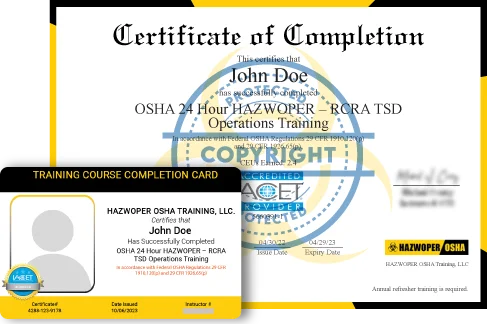OSHA 24 Hour HAZWOPER – RCRA TSD Operations Training
In accordance with Federal OSHA Regulations 29 CFR 1910.120(p) and 29 CFR 1926.65(p).
Customer Reviews
“After months of intense research, I chose HAZWOPER OSHA’s LMS. Along with the super-simple self-registration for each learner, I get basically zero support calls despite having over 3,200 novice users!”
Chris Bauer, Chief Engineer
“I am not a tech savvy but the system is really easy to use. I have required some help to make sure everything works smoothly; I cannot be more grateful for the quick responses and support they have given me.”
Mike Reeves, Machine Engineer
“We've been using this course for a couple of years now to train new employees and renew existing certifications and we are amazed how quickly the course content is updated whenever there is a new mandate out or a change in EPA regulations.”
Linda B. Warner, Site Material Specialist
"Upon the completion of this training program, I have acquired valuable skills that I can now apply within my current workplace."
Cathy O'Brien, Waste Control Operator
"Understanding the concepts of HAZWOPER is challenging, but this course was presented in a way that proved remarkably clear and accessible. The quiz in all lessons of the course were especially helpful."
Cassandra Parkinson, Production Scheduler
"The learning system was great, allowing me to seamlessly finish the entire course on my iPhone without any interruptions. The video quality was good as well. Keep up the outstanding work!"
Benjamin Sinclair, Debris Control Officer
*** After registering, learners will have three months to complete the training and one year to access the training materials. ***
OSHA 24 Hour HAZWOPER - RCRA TSD Operations Training course is designed for individuals seeking initial Hazardous Waste Operations and Emergency Response (HAZWOPER) certification for work, in compliance with OSHA’s HAZWOPER regulations, 29 CFR 1910.120(p)(7)(i) and 29 CFR 1926.65(p)(7)(i) for the general and construction industries, respectively. This section applies to workers engaged in operations at treatment, storage, and disposal facilities (TSDFs) for hazardous waste. Such work operations are usually associated with handling and managing RCRA hazardous wastes.
According to OSHA’s HAZWOPER standards, workers engaged in operations at TSDFs must receive a minimum of 24 hours of initial training in order to perform their assigned duties safely and effectively. This training should be a part of the employer’s Safety and Health Program. Additionally, an 8 Hour refresher course is required for TSDF workers in order to maintain their initial certification.
Guaranteed Price Match - Plus $10 Off!
If you find a better price for this course, we will match that price plus take $10 off. Our course is the best on the web, and the best value too. To redeem this offer create an account, then contact us on 1-866-429-6742.
Some of the benefits of HAZWOPER OSHA Online Training
Once you complete the required study time, you can take the final exam. Upon passing the final exam you will receive an electronic OSHA 24 Hour HAZWOPER - RCRA TSD Operations Training course completion certificate which will be emailed to you immediately. The Plastic Wallet ID Card will arrive via U.S. mail within 2-3 weeks after you upload or email your passport-style photograph.
- Our online support is available 24/7, 365-days a year.
- Our telephone support is available Monday to Saturday 6:00 AM to 5:00 PM (Pacific time).
Please reach us via:
- Email: [email protected]
- Toll-free: (866) 429-6742
- Local: (310) 498-0546
Our interactive course adds more value for the learner - by creating a two-way dialogue – enabling a personalized, user-focused experience from start to finish. We periodically update content and add new video animations and graphics and employ other modern learning tools to make learning easy and user experience enjoyable.
This OSHA 24 Hour HAZWOPER - RCRA TSD Operations Training course is narrated by professional narrators, who KNOW how to bring their words to life in an enthusiastic, conversational tone. We firmly believe that the right voice can help elevate your learning experience.
Please click here to view the demo.
This OSHA 24 Hour HAZWOPER - RCRA TSD Operations Training course is taken entirely online. The material can be accessed anywhere, anytime from a computer, iPad®, iPhone®, or an Android® device of your choice. All you need is a fast internet connection and access to a web browser. This OSHA 24 Hour HAZWOPER - RCRA TSD Operations Training course is built using HTML 5, making it more compatible with the browser on your smartphone or another mobile device such as a tablet.
Our cloud-based Learning Management System (LMS) tracks your OSHA 24 Hour HAZWOPER - RCRA TSD Operations course training progress, allowing you to switch between your computer and mobile devices without repeating any content.
You can stop training in the middle of a lesson on one device and pick it up at the same spot on another. There is no need to complete an entire lesson to move from one device to another, thereby enabling you to obtain your HAZWOPER certification without hassle.
Supported Browsers
 Mozilla
MozillaFirefox
 Apple
AppleSafari
 Microsoft
MicrosoftEdge
 Google
GoogleChrome

The core objective of the OSHA 24 Hour HAZWOPER - RCRA TSD Operations Training is to meet OSHA’s HAZWOPER training requirements as specified in 29 CFR 1910.120(p)(7)(i) for the general industry and 29 CFR 1926.65(p)(7)(i) for the construction industry.
According to 29 CFR 1910.120 (p)(7)(i) and 29 CFR 1926.65(p)(7)(i):
“The employer shall develop and implement a training program which is part of the employer's safety and health program, for employees exposed to health hazards or hazardous substances at TSD operations to enable the employees to perform their assigned duties and functions in a safe and healthful manner so as not to endanger themselves or other employees. The initial training shall be for 24 hours, and refresher training shall be for eight hours annually. Employees who have received the initial training required by this paragraph shall be given a written certificate attesting that they have successfully completed the necessary training.”
After completing the OSHA 24 Hour HAZWOPER - RCRA TSD Operations Training course, the following learning objectives will be achieved:
- Understand the various environmental laws applicable to HAZWOPER workers;
- Describe EPA’s cradle-to-grave program for management of hazardous waste;
- Fully understand OSHA regulations and requirements related to TSDF workers;
- Understand the elements of an effective Safety and Health Program;
- Comprehend basic toxicology principles and understand how they are related to chemical exposure;
- Understand the principles of decontamination and explain the decontamination methods used on hazardous waste sites;
- Understand the uses of Personal Protective Equipment (PPE), and identify and select the appropriate PPE related to a particular worksite;
- Outline the monitoring and detection tools available to workers;
- List the criteria for classification of hazardous waste generators into three different categories and the regulations applicable to each;
- Give examples of incompatible chemicals and regulations applicable to specific categories of hazardous waste; and
- Recognize a HAZWOPER site emergency and appropriate response procedures.
OSHA 24 Hour HAZWOPER - RCRA TSD Operations Training Syllabus
The OSHA 24 Hour HAZWOPER - RCRA TSD Operations Training course syllabus consists of 11 modules broken down into 64 lessons. Students are required to take each lesson in sequential order as listed below.
OSHA 24 Hour HAZWOPER - RCRA TSD Operations Training: Introduction
Module 1: Regulatory Overview
The first module of this OSHA 24 Hour HAZWOPER - RCRA TSD Operations Training course provides an overview of the laws and regulations that are applied by the federal government and how information is presented in the Code of Federal Regulations (CFR). It also describes the relevant OSHA and HAZWOPER standards that apply to TSDF operations, details the hazard communication required in such facilities, and the importance of the safety and health program to safeguard workers at the worksite or those exposed to hazardous waste.
- Lesson 1: Laws and Regulations
- Lesson 2: OSHA and the HAZWOPER Standard
- Lesson 3: Hazard Communication
- Lesson 4: Safety and Health Program
Module 2: Medical Surveillance and Toxicology
The second module of the OSHA 24 Hour HAZWOPER - RCRA TSD Operations Training course focuses on the medical surveillance program that must be developed in a TSD facility to monitor and maintain the good health of workers working with hazardous wastes. Three of the lessons also focus on toxicology explaining what it means and the impact on the human body and the health and safety of workers.
- Lesson 5: Medical Surveillance Program
- Lesson 6: Introduction to Toxicology
- Lesson 7: Chemicals and Target Organ Toxicity
- Lesson 8: Factors Influencing Toxicology
Module 3: Hazard Classification
This third module focuses on the prevalent hazards in a worksite where operations revolve around hazardous waste and other hazardous substances. Lessons explain what a job hazard analysis (JHA) is; and discuss the different hazards that workers may be exposed to at the hazardous waste site or when working in TSD facilities.
- Lesson 9: Job Hazard Analysis
- Lesson 10: Physical and Chemical Properties
- Lesson 11: Fire and Oxygen Deficiency
- Lesson 12: Physical, Biological, and Environmental Hazards
- Lesson 13: Bloodborne Pathogens
- Lesson 14: Corrosives
- Lesson 15: Solvents and Oxidizers
- Lesson 16: Reactive Materials and Explosives
- Lesson 17: Radiological Hazards
Module 4: Respiratory Protection
Module four of this OSHA 24 Hour HAZWOPER - RCRA TSD Operations Training course focuses on the importance of respiratory protection for workers exposed to hazardous materials and other dangerous substances in a hazardous waste worksite. Lessons provide in-depth details about respirators and respiratory protection as well as the need for respirator fit testing, training on the use of respirators, and the proper maintenance of respiratory equipment.
- Lesson 18: Introduction to Respiratory Protection
- Lesson 19: Types of Respirators
- Lesson 20: Respirator Selection Factors
- Lesson 21: Respirator Fit Testing
- Lesson 22: Training and Maintenance
Module 5: Personal Protective Equipment
Module five of this safety training course provides detailed guidance on personal protective equipment (PPE) use in a hazardous waste worksite including direction on the use of PPE for the different parts of the body. The use of chemical protective clothing is also explained as pertaining to work operations in the TSD facility. The importance of the proper donning and doffing of PPE is also explained and an example is given.
- Lesson 23: Introduction to PPE
- Lesson 24: Chemical Protective Clothing
- Lesson 25: PPE for the Head, Eyes, Face, and Ears
- Lesson 26: PPE for the Hands and Feet
- Lesson 27: Selection of Chemical Protective Clothing
- Lesson 28: Monitoring and Medical Concerns of PPE
- Lesson 29: Donning and Doffing PPE
- Lesson 30: Inspection and Maintenance of PPE
Module 6: HAZWOPER Site Operations
This module is dedicated to explaining the process for analyzing, identifying, developing procedures, and documenting hazards that can exist in a new hazardous waste site. The module will also explain the elements of effective hazardous waste site control strategies that can be adopted, the use of air monitoring and other toxic atmosphere monitoring devices that may be used as well as the process for personal sampling.
- Lesson 31: Site Characterization
- Lesson 32: Site Control Strategy
- Lesson 33: Introduction to Air Monitoring
- Lesson 34: Direct Reading Instruments
- Lesson 35: Toxic Atmosphere Monitoring
- Lesson 36: Personal Sampling
Module 7: Material Sampling and Analysis
This module explains the importance of material sampling during the initial on-site characterization process and safe work practices that must be implemented when handling drums on a HAZWOPER site. Lessons will provide details on the elements of a field sampling plan and explain the concept of material sampling on a hazardous waste site while differentiating between environmental and hazardous waste sampling methods. How to safely open drums and transport hazardous waste drums while using the appropriate NFPA and/or the Department of Transportation (DOT)’s hazmat warning labels and placards will also be explained in the lessons.
- Lesson 37: Field Sampling Plan
- Lesson 38: Types of Material Sampling
- Lesson 39: Handling Drums
- Lesson 40: Opening Various Types of Drums
- Lesson 41: Drum Sampling and Characterization
- Lesson 42: Drum Transportation
Module 8: Confined Spaces and Excavations
This module outlines the safe work practices associated with work operations in and around excavations and confined spaces including OSHA’s criteria for defining a confined space and the four conditions that would lead to a confined space being designated as permit-required confined space. The lessons also summarize the key responsibilities of a confined spaces supervisor, attendant, and authorized entrant; and give examples of information contained in a confined space entry plan and the three types of air-quality tests that can be performed in a confined space before any worker entry. The lessons on excavations and trenching focus on understanding the responsibilities of a Competent Person on an excavation site, distinguishing between soil types, and the use of protective systems in excavated areas as recommended by OSH regulations.
- Lesson 43: Introduction to Confined Spaces
- Lesson 44: Confined Space Entry Plan
- Lesson 45: Entering a Confined Space
- Lesson 46: Confined Space hazards
- Lesson 47: Confined Space Rescue and Emergencies
- Lesson 48: Introduction to Excavations
- Lesson 49: Soil Classification and Protective Systems
Module 9: Decontamination and Site Emergencies
This ninth module of the course explains the importance of decontamination and the key elements of the emergency response plan for a hazardous waste worksite. Lessons describe what a Personnel Decontamination Station (PDS) is used for, give examples of common decontamination equipment used for decontaminating personnel and equipment, and differentiate between physical and chemical decontamination. Lessons also provide examples of worker-related and hazardous waste-related emergencies on a HAZWOPER worksite, review the elements of an OSHA-required Emergency Response Plan and the role of decontamination during an emergency, as well as the importance of appropriately documenting emergency incidents that occur in a hazardous waste TSD facility.
- Lesson 50: Introduction to Decontamination
- Lesson 51: Decontamination Facility Design
- Lesson 52: Decontamination Methods
- Lesson 53: Emergency Decontamination
- Lesson 54: Introduction to Site Emergencies
- Lesson 55: Site Emergencies Documentation
Module 10: EPA Cradle-to-Grave Program
This module describes the core elements of EPA’s cradle-to-grave program and the steps that must be followed to comply with regulations for the management of hazardous waste. Lessons focus on the Resource Conservation and Recovery Act (RCRA) and its purpose, describe the key elements of RCRA’s Subtitle C and Subtitle D regulations, and explain the EPA’s cradle-to-grave program for the management of hazardous waste. There is also information on the process by which waste generators can identify whether their waste is hazardous; the criteria for the classification of hazardous waste generators into three different categories, the requirements for the two types of hazardous waste storage units—containers and tanks, and summarizes the three different ways facilities can collect and manage their hazardous waste—SAAs, CAAs, and TSDFs, and the regulatory requirements for transporters of hazardous waste.
- Lesson 56: Resource Conservation and Recovery Act
- Lesson 57: Hazardous Waste - An Overview
- Lesson 58: Hazardous Waste Generators
- Lesson 59: Hazardous Waste Storage
- Lesson 60: Hazardous Waste Transportation
Module 11: Regulations for Specific Wastes
This final module of the OSHA 24 Hour HAZWOPER - RCRA TSD Operations Training course describes the procedures for managing spills and emergencies at a hazardous waste site and the specific provisions for handling certain categories of hazardous waste. Lessons mainly cover the Emergency Planning and Community Right to Know Act (EPCRA), explains the term ‘release’ as specified under CERCLA, gives details on the equipment that SQGs and LQGs must maintain in case of emergencies, explains the Land Disposal Restrictions (LDR) Program, and outlines the four categories of universal waste. Lessons also explain the different types of hazardous waste categories – laboratory waste, biohazard waste, used oil, etc. and the specialized management standards that must be adopted when handling such waste types and summarize the dangers of mixing and/or storing incompatible wastes.
- Lesson 61: Managing Spills and Emergencies
- Lesson 62: Regulations for Specific Wastes
- Lesson 63: LDR, Recycling, and Used Oil
- Lesson 64: Universal Waste
Final Examination

This OSHA 24 Hour HAZWOPER - RCRA TSD Operations Training course is designed by OSHA Certified Outreach Trainers and is updated and reviewed as soon as new requirements or regulations are issued by OSHA, EPA, DOT, and other regulatory agencies. The course meets and exceeds the compliance requirements of OSHA 29 CFR 1910.120(p) and 29 CFR 1926.65(p) standards.
HAZWOPER Certification
Once the course is completed, you will be able to immediately download, save or print your OSHA 24 Hour HAZWOPER - RCRA TSD Operations Training Certificate of Course Completion which is provided in PDF format. The plastic wallet card will arrive in U.S. mail within 2-3 weeks.
Training Requirements
There are no prerequisites for this OSHA 24 Hour HAZWOPER - RCRA TSD Operations Training course.
A Final Note
It is important to remember that you are taking the online version of the OSHA 24 Hour HAZWOPER - RCRA TSD Operations Training course as required by OSHA for hazardous waste TSDF workers. The hands-on training and field experience required by the HAZWOPER Standard is not a part of this course.
It is ultimately the responsibility of the employer to provide adequate training to their employees depending on their job type and experience and to meet and fulfill OSHA requirements in the process.
As an employer, do you want to train your employees as a team? Do your employees want to learn from a qualified instructor?
HAZWOPER OSHA offers customized group instructor-led training (ILT). We facilitate virtual training for groups of all sizes, led by OSHA-authorized trainers who guide individuals through the key topics of the OSHA 24 Hour HAZWOPER - RCRA TSD Operations Training as per OSHA 29 CFR 1910.120(p) and OSHA 29 CFR 1926.65(p) regulations.
We can customize this OSHA 24 Hour HAZWOPER - RCRA TSD Operations Training course with your workplace-specific requirements so you can quickly and easily meet your workplace safety and health training goals.
Instructor-Led Training
Rates for the ILT course depends on the number of participants and changes required (if any) to the course content.
Email ([email protected]) or call (1-866-429-6742) us with the:
- Course(s) of your choice,
- Preferred date for scheduling the training, and
- Number of employees expected to be trained.
To learn more about group instructor-led training, click here.
We will get you a quote within 24 Hours!
In-Person Group Training
- Course(s) of your choice,
- Preferred date(s) for the training,
- Location for the training, and
- Number of expected participants.
For more information about in-person on-site safety training, click here.
We will get you a quote within 24 Hours!
‘Large corporations often operate and manage in-house learning management systems (LMS).’
We understand this statement and are ready to support employers in fulfilling their safety training goals by providing you with SCORM 1.2 or SCORM 2004 compatible safety training course files.
If you are in search of SCORM compliant safety training courses developed in compliance with OSHA, HAZWOPER, NFPA 70E, DOT Hazmat, and RCRA safety regulations, then you are at the right place!
As experts in the field of safety training, we at HAZWOPER OSHA Training are aware of the various methods employers use to train their employees. Therefore, we are prepared to develop customized SCORM packages to suit your organization’s safety training needs. As such, we can convert this online OSHA 24 Hour HAZWOPER – RCRA TSD Operations Training course into a SCORM package to enable you to train your employees using your company’s LMS, making training accessible and hassle-free.
For information on rates, email ([email protected]) or call (1-866-429-6742) us, and we will get you a quote within 24 Hours!
To learn more about SCORM Packages, click here.
- Newly recruited employees of RCRA permitted hazardous waste treatment, storage, and disposal facilities due to their continued exposure to hazardous materials and other health hazards must receive this training to ensure safety and health in the workplace.
- Current employees of RCRA permitted hazardous waste treatment, storage, and disposal facilities who do not meet the training requirements as specified by OSHA.
To receive a plastic wallet ID card, upload a passport-style and size photograph to your HAZWOPER OSHA Training account. Alternately, email the photograph to [email protected]. You will receive the plastic wallet card via U.S. mail within 2-3 weeks of course completion.



